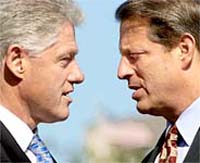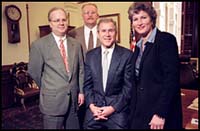
| Headlines |
| Davis Op-Ed |
| week of: |
| Sept. 27th |
| Oct. 4th |
| Oct. 11th |
| Oct. 18th |
| Oct. 25th |
| Nov. 1st |
| Nov. 8th |
| Nov. 15th |
|
President
Clinton's Role in the Campaign |
|
||
|
|
How
Would George W. Bush Govern? What can we learn from George W. BushÕs six years as Governor of Texas about how he might handle the decision-making responsibilities of the Presidency? How would he work with his staff? How would he gather the information needed to make decisions? How would those decisions be communicated? Source: The washington post |
||
|
McCain
Campaigns with Bush in New England source: The New York Times |
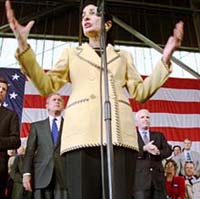 Gov. George W. Bush and Senator John McCain of Arizona stood with Senator Olympia J. Snowe yesterday at a rally in Bangor, Me. |
||
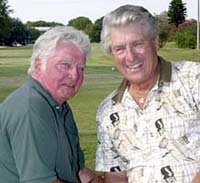 "We're all retired. But we all think differently," said Bill Roberts, 66, left, after a round of golf with Richard Mikszenas, 68, in Clearwater, Fla. |
Senior
Citizens: A Key Constituency in Florida |
||
|
The
Place of the Vice President in the Next Administration
|
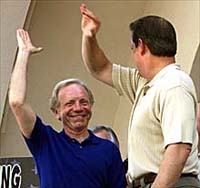 Joe Lieberman, left, high-fives Al Gore during the Democratic running mates' appearance at a campaign rally in Orlando, Fla. AFP |
||
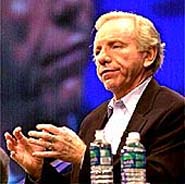
Lieberman often mentions his faith on the campaign trail. This week, he spoke to high-tech workers in Lake Buena Vista, Fla. AP |
Centrist
or Traditional Liberal: Who Is the Real Joe Lieberman? Has Democratic Vice Presidential nominee Sen. Joseph Lieberman moved to the left since being nominated, in order to energize and mobilize traditional Democratic constituencies? Or does he continue to be a man of the moderate middle? This profile of Lieberman provides biographical information on a man who until this summer was little known outside of Connecticut and Capitol Hill. Source: The LA times |
||
|
Gore
Plans an Advertising Blitz Source: The Washington post |
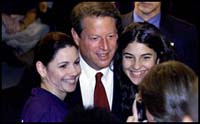 Vice President Gore, shown here at a campaign stop in Maryland Saturday, is hoping that a new round of attack ads will turn things around for him before Election Day. (AP Photo) |
||
|
Foreign
Policy Becomes an Issue in the Campaign
|
Turnout
Among African-Americans: A Key Factor in Battleground States The turnout rate among African-American voters may determine who wins key battleground states such as Michigan, Ohio, and Pennsylvania. Since African-Americans cast 80% of more of their votes for Democratic candidates, the Gore campaign is working closely with the NAACP and other organizations to ensure a large turnout of African-Americans. The Republicans are not going to concede the African-American vote without a fight. Source: The Washington Post |
||
|
Election Analysis and Commentary Sunday, October 22, 2000 Eric L. Davis Will Ralph Nader affect the outcome of this year's Presidential election? Nader is doing well enough in a few states, such as Oregon, Washington, and Wisconsin, that he could tip the electoral vote in those states to George W. Bush. Nader draws his votes primarily from Al Gore. If Nader were not on the ballot, most of his voters would support Gore rather than Bush. In previous elections, many supporters of third-party candidates have decided in the last few days before the election to vote for one of the two candidates who has a legitimate chance of winning the Presidency. The third-party supporters have made this choice in order to prevent their least-desired candidate from being elected. Will that happen this year? Will Nader supporters in states where the race is close vote for Gore in order to prevent Bush from winning their states' electoral votes? Nader is most unlikely to receive any electoral votes himself. However, receiving five percent of the vote nationwide is a goal that is more important to him than gaining electoral votes. The Federal Election Campaign Act provides that any political party whose candidate receives five percent of the vote is eligible for partial reimbursement of electoral expenses from federal funds after the election. More importantly, such a candidate is eligible for grants from the Federal Election Campaign Fund in the next election cycle. So if Nader receives more than five percent of the vote in 2000, the Green Party would be eligible for federal funding in 2004. Over the course of the twentieth century, third-party candidates have had effects on the political system that have taken longer than a single election cycle to become evident. These effects are illustrated by two of the most important third-party Presidential candidates in the twentieth century: Progressive Robert M. LaFollette in 1924, and American Independent Party candidate George C. Wallace in 1968. LaFollette's candidacy illustrates how a third party candidate can raise issues that make their way, a few election cycles later, onto the agenda of one of the major party candidates. In 1924, the major party candidates were incumbent Republican Calvin Coolidge, and Democrat John W. Davis, a Wall Street lawyer. LaFollette, like Nader this year, excoriated the two major party candidates for being indistinguishable from each other, since they were both handmaidens of corporate America. Unlike Nader, LaFollette did not begin his career in electoral politics by running for the Presidency. When he ran for President in 1924, he had been a member of the United States Senate since 1906, and he had served three terms as Governor of Wisconsin before going to Washington. Among the planks of LaFollette's Progressive Party in 1924 were government regulation, if not takeover, of the railroads; easier credit for farmers; government support to bring electric power to rural areas; the outlawing of child labor; the right of workers to organize unions; increased protection for civil liberties; and federal anti-discrimination laws. LaFollette won almost 5 million votes in 1924. He carried his home state of Wisconsin, ran second in eleven Western states, and did very well in working-class wards of New York and other major Eastern cities. The rural-urban populist coalition that LaFollette assembled in 1924 became an important part of Franklin D. Roosevelt's New Deal coalition a decade later. Many of the programs LaFollette advocated in 1924- such as federally-supported rural electrification, government loans for farmers, and the protection of workers' rights to unionize - became part of the Democratic party's platform in the 1930s, and were pushed through Congress by President Roosevelt and his Democratic allies on Capitol Hill. In many ways, LaFollette and the Progressives of 1924 were important harbingers of FDR and the New Deal. George Wallace illustrates a different effect of third-party candidates on American politics. Wallace had been elected Governor of Alabama as a Democrat in 1962. In his inaugural address, delivered in front of the Alabama State Capitol over which the Confederate flag flew, he vowed to "draw the line in the dust and toss the gauntlet before the feet of tyranny, and I say, segregation now, segregation tomorrow, segregation forever." As Governor, Wallace literally "stood in the schoolhouse door" to prevent an African-American student from registering to attend the University of Alabama. In 1968, Wallace launched his independent candidacy for President, vowing there was "not a dime's worth of difference" between Republican Richard Nixon and Democrat Hubert Humphrey. Wallace's appeal was primarily to white Southerners, but he attracted some support among working-class voters in Northern cities as well. His campaign included a defense of traditional patterns of race relations, emphasized Wallace's opposition to the Civil Rights Act of 1964 and the Voting Rights Act of 1965, and stressed his attacks on "pointy-headed bureaucrats" who wanted to involve the federal government in more and more aspects of daily life. In the 1968 election, Wallace received 46 electoral votes, from Alabama and four other states in the Deep South, and 13 percent of the popular vote. Many of the white Southerners, and some of the working-class Northerners, who voted for Wallace for President in 1968 voted for Republican Nixon in 1972, and, over the course of the 1970s, changed their party identification from Democrats to Republicans. As the Civil Rights Act and the Voting Rights Act eliminated Jim Crow and allowed African-Americans to register and vote in Southern elections, many white Southern Democrats left the party that supported those civil rights laws. These voters moved to the Republican party, which in many Southern states was a weak organization ready to be taken over by those with conservative views on racial matters. The principal effect of the Wallace candidacy of 1968 was to serve as a way station for white Southerners who were leaving the Democratic party, but could not go all the way to the Republicans just yet. As with LaFollette, will parts of Nader_s agenda end up being adopted by one of the major parties, presumably the Democrats, over the next decade? As with Wallace, will Nader's candidacy end up serving as a way station for voters transitioning from one of the established parties to a new political organization? The answers to these questions will not be known for several election cycles, but they could turn out to be far more important for the long-term future of American politics than the share of the vote received by Ralph Nader this year. |
|||
|
|
|||
